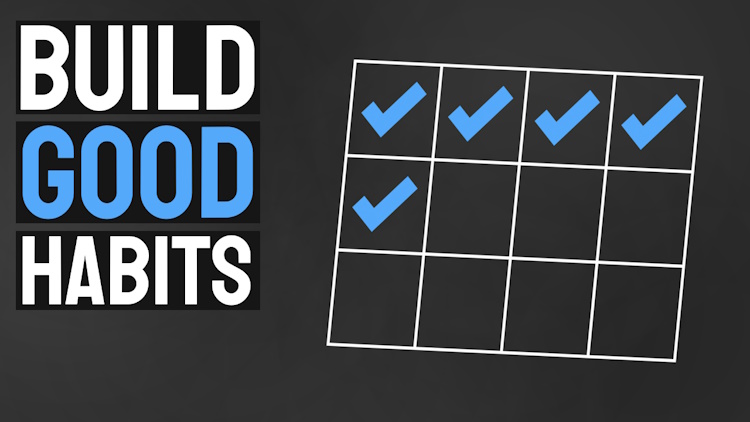How to Build Good Habits and Get Rid of Bad Ones
In this article, you will learn how to build good habits that are easy to stick to. You will also discover a simple strategy that has helped me increase my good habits while replacing bad ones in my life.

Some of the links in this article may be affiliate links, which can provide compensation to us at no cost to you.
Introduction
The challenge of maintaining habits is a common struggle. It’s especially true for those of us who have attempted to start a new and beneficial hobby, learn a new skill, or adopt a positive daily routine.
Why is it so difficult to establish productive habits and routines? Wouldn’t it be nice to develop a habit of reading or writing a book, or perhaps working on a side project every day to make progress?
Creating a habit isn’t easy when approached in the traditional way without some tricks, which I’ll share in this article.
Habits have a long-term impact on our lives, either positively or negatively, depending on the habits we’ve adopted. Habits have also built into our lives gradually, in long-term. The good news is that you can consciously build good habits, and it’s easy when you know how.
On the other hand, bad habits can’t simply be erased; they need to be replaced with new, preferably better habits.
This article draws inspiration from the book Atomic Habits by James Clear. This masterpiece delves into the heart of habit formation and explores how you can develop positive habits while breaking free from bad ones. In my opinion, this book should grace the bookshelves of anyone who has ever pondered improving their life.
What is a Habit?
A habit is simply a recurring behavior pattern that we perform daily. Every person has habits because without them, life would be chaotic.
Habits serve to ease mental load. When we follow a habit, we shift the execution of previously learned tasks partially to our subconscious, freeing up mental space for thinking and decision-making. This allows us to direct conscious thought towards new and critical matters demanding immediate attention.
If something is repetitive and predictable, we can let it happen subconsciously, saving our conscious minds for more important decisions.
 Make your subconscious work for you
Make your subconscious work for youWhen we repeat an action enough times, our brains form neural connections that help us perform the same action automatically in the future, without having to consciously think about how to do it. Habit formation requires a lot of repetition, which can sound mundane for someone, but I will tell later how we can go through it more easily.
A habit can trigger when we do something entirely different, prompting us to react in our usual way. For instance, after waking up in the morning, we go to the bathroom, see our toothbrush by the sink, and automatically brush our teeth during that bathroom visit. We don’t need to put much thought on doing it.
The actual performance, along with the associated muscle memory, is so familiar that we execute it as if it’s hardwired into us because we’ve done it thousands of times before. We either start from the top or bottom, left or right, and follow the same motion with our hand each time.
If someone were to record our tooth-brushing routine, it would look almost identical every day. This is what a strong neural connection to a particular action looks like in practice.
Occasionally, we might consciously attempt a different way, perhaps recommended by our dentist, but then we must concentrate because the new habit doesn’t come naturally.
On the flip side, a negative example might be picking up your phone from the table as soon as you receive a new notification and checking what it is without thinking beforehand your action. We don’t consider our actions; we just follow them because we’ve grown accustomed to doing so.
Habit of checking phone every eight minutes can be mentally draining, and it breaks our focus if we are trying to do something productive. Habits develop gradually, but once they are ingrained in your life, changing them consciously becomes challenging.
Habits and routines formation applies to artists, musicians, dancers, and athletes too. They’ve repeated the same movements so many times that they no longer need to consciously perform them; they happen automatically. The performance in a competition or other situations results from years of practice, and the movement has been honed to perfection. They don’t have to think about how to do it perfectly every time, it’s coming naturally.
Imagine if, for example, a gymnast had to consciously think about each move in every performance. The performance would be ruined, and the gymnast would constantly make mistakes if they had to remember how to perform each move and when to execute it with a high level of detailed control. That’s why they practice to the point where things come quickly and cleanly from their subconscious.
Habits are formed through a four-step process:
- Cue: Cue, also known as trigger, works as a signal that initiates the habit. It could be a specific time, place, emotional state, other people’s presence, or an immediately preceding action.
- Craving: Once the cue occurs, it triggers a craving, a desire for a specific outcome. This is the motivational force behind every habit. For instance, the cue might be feeling hungry (a common cue), and the craving is the desire for food.
- Response: The response is the actual behavior or action you take to satisfy the craving. This is the habit itself. If you’re hungry, the response might be to eat a sandwich.
- Reward: The reward is the outcome of the habit, and it satisfies the craving. In our example, eating the sandwich rewards your hunger and provides nourishment.
Good Habits VS Bad Habits
We all have a multitude of habits that we do daily, whether we intend to or not. They inevitably form because our brains would be overwhelmed without them.
If you’re not aware of your good habits, you may inadvertently have adopted many bad ones, as we are not always aware of our bad habits.
As we become mentally tired in the evening due to the hundreds of choices we have made during the day, we start executing our automatic habits because we can no longer muster the energy to make new conscious choices.

These habits are often negative because they are easy to perform and provide immediate gratification, so they easily creep into our daily lives. Negative habits include mindlessly watching television, YouTube, or TikTok, extended gaming sessions, unhealthy snacking, or ordering fast food.
Bad habits may have consequences over time, such as excess weight gain from snacking, slouching from hunching over your phone, or poor physical fitness from sitting too much and not exercising.
I have also succumbed to the bad habits mentioned, but I can say that replacing them with better habits has made my life better.
When I understood the power of habits, I could consciously do more of what might be a bit challenging in the moment but would make my future easier and make me happier. If I did what is easy now, my life would be harder and unhappier in the future.
 Aphorism
Aphorism- Jerzy Gregorek
Small daily actions are considered insignificant by many because they seem so small and are so mundane. How could they possibly wield power over the direction of your entire life? However, these small daily choices have led you to where you are now.
Many people think that the major life choices we’ve made have put us on the path we’re on. These big decisions are just the result of thousands of everyday small choices.
Small-seeming habits should never be underestimated because they guide where we’re going in life, as we do them daily and they accumulate over time into significant consequences.
Simple habits become visible results when enough time has passed. Since time inevitably passes, wouldn’t it make sense to examine your daily habits and adjust them to be more positive if you want to influence whether your future is bright or bleak?
Saving money is a good example of this. Many people say they can’t afford to save money because all their income goes towards living expenses.
What if, instead, you stopped complaining and put 10% of your income into savings on payday, in a sensible place where it could potentially grow with interest? I can guarantee that with 90% of your normal income, you can maintain the same standard of living you have now, as our spending tends to closely follow our earnings.
You’ll thank yourself during tough months when expenses are higher or years down the line when your wealth has accumulated significantly. If you don’t save, you’ll live paycheck to paycheck and regret not having money for a rainy day.
Let’s now go to the juicy part of how to form the good habits.
The Best Way to Form Good Habits
I have learned many skills in recent years, such as reasonably good writing, advances 3D modeling and animation skills, creating YouTube thumbnails and videos, and understanding previously completely foreign languages like Polish.
I have learned 3D modeling skills from 0 with daily habit of practice.

These skills have developed gradually because of daily habits and routines that I consciously built.
For instance, I practice foreign languages every day on the Duolingo app during my first 10-minute break of the day. Just 10 minutes a day has taught me hundreds of new words, how to pronounce Polish words, and the basics of grammar over the course of a year. I know that if I continue this habit for a few more years, I’ll be able to speak the language fluently.
You, too, can easily create habits that help you complete daily tasks more efficiently, learn new skills , and get things done. You can change the direction of your life over time if you incorporate good habits into your daily routine.
Let me give you example: as I write this, I’ve been doing push-ups every day for a month.
Today, I did 31 push-ups, yesterday 30, and the day before 29. You might understand where I’m going with this example: a month ago, I started doing push-ups, beginning with just one push-up. The secret to making habits stick is to start small and be committed to input, without focusing the output.
I’ve done one more push-up each day than the previous day. I could argue that doing one push-up is something anyone with arms can do. Doing two and then three push-ups is almost equally easy. As the number of push-ups performed increases, the habit solidifies, and it becomes almost automatic.
When you start with an extremely easy task and gradually increase the difficulty each day, habit formation becomes easier. The idea is that it must initially be ridiculously easy to perform to ensure it gets done. Think of the simplest and easiest thing that could be related to forming the habit you desire.
Do you want to exercise more? Lay out a yoga mat at a specific time of day, lie down on it, and do a single sit-up. The next day, lay it out again and do a short set of sit-ups. The following day, do two sets, and so on.
If this seems too challenging to do every day, make it even easier. Keep the yoga mat laid out in the middle of your living room. You’re more likely to use it when it’s already open and inviting.
In fact, I’ve personally taped my yoga mat in the middle of my living space. Every morning when I see it, I feel like stretching or doing a quick workout in the afternoon. This is called environmental design.
If you know you should exercise on a given day but you’re not in the mood, put yourself in a state of mind where you want to work out. Put on workout clothes and play some “pump-up” music, and you’ll instantly feel more motivated to be active. If you listen to the same songs every time, your brain will know it’s time to exercise, making it easier to get started!
When you continue a habit and raise the difficulty level every day, without skipping days, studies show that after two months, it becomes a permanent habit. At that point, not doing the habit becomes more challenging than doing it, and you’ll complete it automatically without any mental resistance.
People quit their habits when they’re still in the formation stage, usually when something unexpected happens in their life. You might get sick, go on a trip, attend parties, or simply be in a bad mood and not feel like doing the habit.
There are also days when I don’t feel like learning a language. On those bad days, I do just one Duolingo exercise, which takes only a few minutes. But it keeps me in the habit. Often, my mind doesn’t feel like practicing, but after doing one exercise and receiving a reward of “double XP” for 30 minutes, I often continue with another or a third exercise.
Consistency is crucial for habits. If you miss a day for some reason, it’s not a big deal. But never skip two days! If you skip two days, you’re more likely to fail in habit formation because it’s already beginning to break. The threshold to continue it increases day by day. This is why one slip is allowed occasionally, but not two.
This is why you need a minimum requirement to keep the habit going. If, on a particular day, I don’t feel like doing any push-ups, I still do one. At least I executed my habit, and I didn’t skip a day, even though I technically failed that day. Giving up completely, however, is detrimental to the habit.
Besides, most of the time when I do one push-up, I end up doing at least ten. Starting is the hardest part because we often have mental resistance to doing things, we know we should do.
Remember to visually record the days you’ve completed the habit. You can do this with a physical calendar, a smartphone calendar, or a routine-related app. When you visualize your habit, you see progress day by day, and you don’t want to break the chain because you can see the consequences clearly.
A good habit leads your future self to a better situation than your current one, while a bad habit leads to a worse situation. Keep this in mind when you return to your day after reading this – are the habits in it good, or are they something you shouldn’t be doing?
How to Start Building a Habit
Next, you can begin applying habit formation to your life, and you can start today.
First, decide on the habit you want to add to your life. It’s not advisable to start adding multiple habits at once; instead, try forming one habit first. Once that becomes established, you can create a good new habit or link it to an existing one. Linking habits together makes them easier to remember to perform.
For example, if you place dental floss next to your toothbrush and form a habit of flossing your teeth after brushing, your dentist and your future self will thank you for preventing gum disease before it damages your teeth.
Start in an easy and realistic way that makes the initial days as simple as possible. Design your environment in a way that reminds you of the habit. If your gym clothes and shoes are in a closet, forming the habit of going to the gym is more challenging. So, make it easy to remember and execute – if they are already packed in your bag, you are more likely to head to the gym.
If you want to break a bad habit, make it more challenging to perform. If your habit is to play video games or watch TV every night, unplug the power cord or hide the remote control in another room after using them.
Remember that habits cannot be destroyed; they need to be replaced. Replace bad habits with good ones. Swap energy drinks to tea and sodas to water.
Increase your effort towards the habit gradually. The first few days should be very easy. Aim not to skip days, but if you do miss one, don’t give up; continue the next day. One slip is allowed occasionally, but not two.
Keep a visual record of the days when you have completed your habit. You can do this with routine-related app. When you visualize your habit, you see progress day by day, and you don’t want to break the chain because you can see the consequences clearly.
After you’ve executed a habit for about two months, you’ve established enough neural connections in your brain, and it becomes automatic. Habit formation gets easier the more time passes. At 1 month mark, the habit starts to stick already.
Remember that habits form both in a positive and negative direction. So, from time to time, assess your day and consider what you could do differently. Are there any habits you’d like to break and replace with better alternatives?
Building good habits and breaking bad ones is a skill that can significantly impact your life. By understanding the habit loop and following the steps outlined in this article, you can take control of your habits and steer your life in a positive direction.
Remember that change takes time, and setbacks are normal. Be patient with yourself and stay committed to your goals. Over time, you’ll find that your good habits become second nature, and your bad habits lose their grip on your life.
 Book suggestion for forming good habits
Book suggestion for forming good habits
